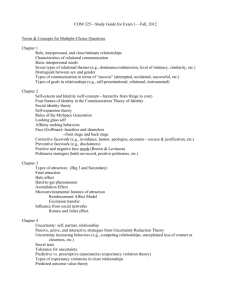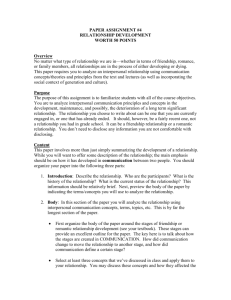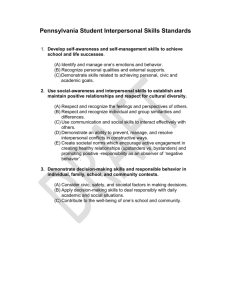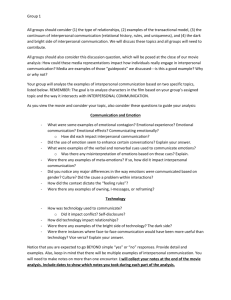What is Interpersonal Communication
advertisement
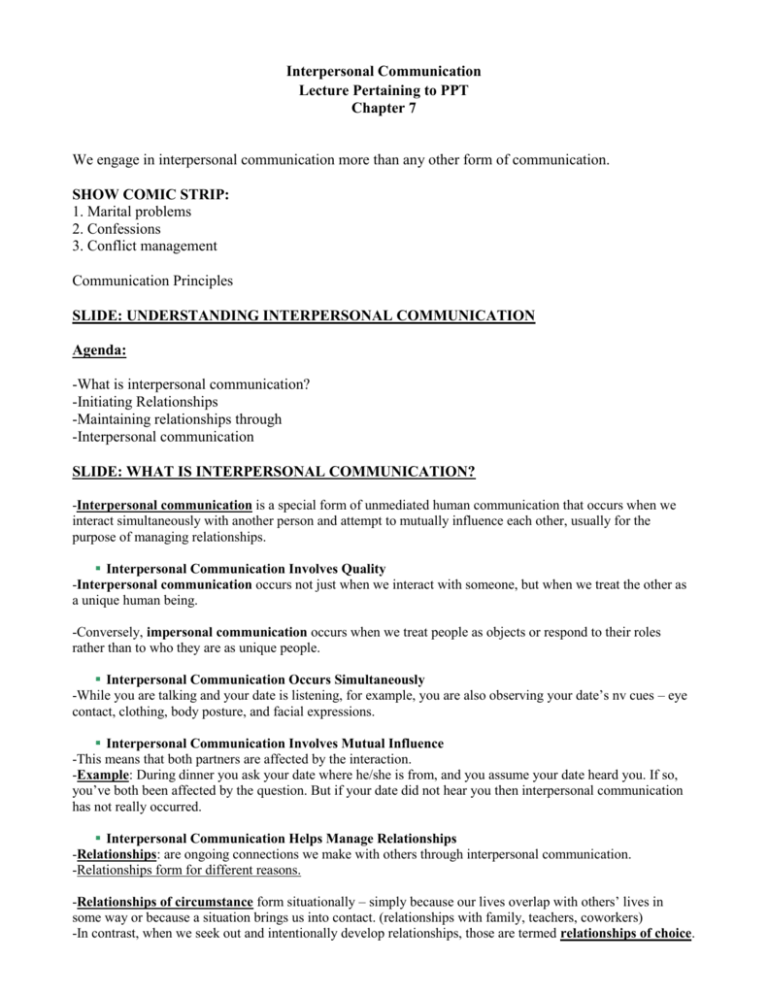
Interpersonal Communication Lecture Pertaining to PPT Chapter 7 We engage in interpersonal communication more than any other form of communication. SHOW COMIC STRIP: 1. Marital problems 2. Confessions 3. Conflict management Communication Principles SLIDE: UNDERSTANDING INTERPERSONAL COMMUNICATION Agenda: -What is interpersonal communication? -Initiating Relationships -Maintaining relationships through -Interpersonal communication SLIDE: WHAT IS INTERPERSONAL COMMUNICATION? -Interpersonal communication is a special form of unmediated human communication that occurs when we interact simultaneously with another person and attempt to mutually influence each other, usually for the purpose of managing relationships. Interpersonal Communication Involves Quality -Interpersonal communication occurs not just when we interact with someone, but when we treat the other as a unique human being. -Conversely, impersonal communication occurs when we treat people as objects or respond to their roles rather than to who they are as unique people. Interpersonal Communication Occurs Simultaneously -While you are talking and your date is listening, for example, you are also observing your date’s nv cues – eye contact, clothing, body posture, and facial expressions. Interpersonal Communication Involves Mutual Influence -This means that both partners are affected by the interaction. -Example: During dinner you ask your date where he/she is from, and you assume your date heard you. If so, you’ve both been affected by the question. But if your date did not hear you then interpersonal communication has not really occurred. Interpersonal Communication Helps Manage Relationships -Relationships: are ongoing connections we make with others through interpersonal communication. -Relationships form for different reasons. -Relationships of circumstance form situationally – simply because our lives overlap with others’ lives in some way or because a situation brings us into contact. (relationships with family, teachers, coworkers) -In contrast, when we seek out and intentionally develop relationships, those are termed relationships of choice. -include friends, lovers, relational partners. -categories are not mutually exclusive – they can evolve into the other. SLIDE: INITIATING RELATIONSHIPS Interpersonal attraction: Why We Like Whom We Like -Attraction, in general, is a motivational state that causes someone to think, feel, and behave in a positive manner toward another person. -More specifically, interpersonal attraction is the degree to which you desire to form and possibly maintain an interpersonal relationship with another person. -Interpersonal attraction occurs in both the early and later stages of relational development. -Short-term initial attraction: is the degree to which you sense a potential for developing an interpersonal relationship. (crush on a classmate) -Long-term maintenance attraction: is the type that sustains relationships like you best friendships or marriage. It refers to a level of liking or positive feelings that motivate you to maintain or escalate a relationship. SLIDE: ELEMENTS OF IP ATTRACTION o Similarity -Attraction increases if we have like characteristics, values, attitudes, interests, and personality traits with another person. -You may also be attracted more to persons who are similar to you in age, intelligence, and life goals. -In the initial stages of a relationship, we try to emphasize positive information about ourselves to create a positive and attractive image. We reveal those aspects of ourselves that we believe we have in common with the other person, and the other person does the same. o Physical and Sexual Attraction -Physical: this form of attraction relates to finding another person’s physical self appealing. -That appeal may be based on height, size, skin tone and texture, clothing, hairstyle, makeup, vocal qualities, gestures, and so forth. -Sexual: this form involves the desire to have sexual contact with a certain person -You may be physically attracted to someone but not sexually attracted. -Each culture teaches and perpetuates its own definition of physical ideal. -Our perceptions about others’ physical attractiveness reduces relationship possibilities. This means that, in general, while we may be attracted to arrange of persons, we tend to seek out individuals who represent the same level of physical attractiveness as ourselves. This is termed the matching hypothesis. o Proximity -We are more likely to be interpersonally attracted to people who are physically close to us rather than farther away. -physical proximity increases communication opportunities. o Complementarity -We may be attracted to persons with abilities, interests, and needs that differ from our own but that balance or round out our own. -Example: if you are highly disorganized by nature (and that is fine by you), you might be attracted to someone who is very organized because you appreciate that person’s sense of structure. -Social psychologist Will Schutz identified three interpersonal needs that motivate us to form and maintain relationships with others: inclusion, control, and affection. -inclusion: represents the need to include others in our activities or to be included in theirs. -control: represents the need to make decisions and take responsibility or the level of willingness to accept others’ decision making. -Affection: represents the need to be loved and accepted by others or the willingness to give love and acceptance to others. SLIDE: COMMUNICATING OUR ATTRACTION -The amount of interaction we have with someone indicates the level of attraction in the relationship. -When we are attracted to people, we use both indirect and direct strategies to communicate our liking though nv and verbal cues. -NV cues are often referred to as immediacy: feelings of liking, pleasure, and closeness communicated by such nv cues as eye contact, forward lean, touch, and open body orientation. -Immediacy behaviors work to reduce the physical and psychological distance between persons. SLIDE: GETTING THE FIRST CONVERSATION GOING o Reducing Uncertainty -Uncertainty reduction theory: a driving human motivation to increase predictability by reducing the unknown in one’s circumstances. -Communication researchers Berger, Calabrese, and Bradac contend that this driving motivation among humans to reduce our uncertainty prompts us to communicate. We typically respond to uncertainty in three ways – using passive, active, and/or interactive strategies. -Passive: observing and gathering useful information without interacting -Active: getting opinions and information from third parties -Interactive: getting opinions and information from those parties most directly involved o What Do You Say First? -One of the best strategies is to find something you perceive you might have in common with the person. o The Art and Skill of Asking Great Questions -Asking a great question means that, first, you tailor the question to the person as much as possible. -Don’t ask too many “yes/no” or “one-word” responses. -Avoid questions that might be too personal and probing. -A second very critical skill is to really listen to the person’s answers to your questions. Then pose a follow-up question. -Avoid talking about yourself too much. Terms for this behavior include conversational narcissism (view that one is center of the universe) and a self-absorbed communicator style (dominating communication style in which one focuses attention on the self…use of “I”) -Self-absorbed = No one’s day is as bad, no one’s opinion as valuable nor information as correct. -It is not what you say, but how you respond to what others say that makes a good conversationalist. o The Art and Skill of Giving and Receiving Compliments -Jane Holmes, British linguistic calls compliments “social lubricants” -Giving compliments is a tricky business, because some attempts at flattery can be taken in ways other than you intend. -The best response to a compliment is a simple “thank you” that acknowledges that something nice was said about you. SLIDE: MAINTAINING RELATIONSHIPS THROUGH IPC Self disclosure: Revealing yourself to others -Self disclosure, originally research by psychologist Sidney Jourard, occurs when we voluntarily provide information to others that they would not learn if we did not tell them. o Reciprocity in Self-Disclosure -Reciprocity: meaning that when we share information about ourselves with other persons, we expect them to share information that is similar in risk or depth about themselves. o Appropriateness in Self-Disclosure -Appropriateness: is another key variable related to self-disclosure. -Certain kinds of information are inappropriate to disclose at an early stage, but appropriate at a later stage of relational development. o Assessing the Risks of Self-Disclosure -What is high self-disclosing for one person may be low self-disclosing for another. -While the level of intimacy (or risk) in the information increases over time, the amount of disclosure tends to decrease as the relationship becomes more and more intimate. -By revealing information to another person, you give that person a degree of power over you. o Self-Disclosure, Intimacy, and Gender SLIDE: MODELS OF SELF-DISCLOSURE o The Social Penetration Model -Irwin Altman and Dalmas Taylor: social penetration model: illustrates how much and what kind of information we reveal in various stages of a relationship. -In their theory, interpersonal communication in relationships moves gradually from the superficial to the more intimate. -Two aspects of this communication increase: the breadth of the information (the variety of topics discussed) and the depth (the personal significance of what is discussed). -Their model is a configuration of rings, commonly referred to as concentric circles. -Superficial level – Intimate level – Very intimate level o The Johari Window -Reflects various stages of relational development, degrees of self-awareness, and others’ perceptions of us. DRAW ON BOARD: Known to Other Not known to other known to self Not known to self 1 Open 2 Blind 3 4 Hidden Unknown -Open quadrant represents that part of yourself that you know and have revealed to the other person. As a relationship becomes more intimate, the Open quadrant grows larger. -The Hidden quadrant is information you know about yourself but have not shared with other person. This quadrant is fairly large initially; but as you self-disclose, it shrinks, and Open quadrant grows. -Unknown quadrant is that part of yourself which you have yet to discover or realize. As you learn and selfdisclose more, or as others learn more about you, this quadrant becomes smaller and smaller. -Sometimes our friends observe things about us that we don’t realize or perceive about ourselves. This kind of unintentional self-disclosure is represented by the Blind quadrant. Expressing Emotions (ILLUSTRATE ON BOARD) -If you placed emotional expression on a continuum according to cultural groups, with one end being open approach to emotional display (A) and the other end being the suppression of emotional display (B): A B ---------------------------------------------------------------------I----------------------------------------------------------------------Latin Cultures U.S. Culture Asian Culture -NV study found that, at very young ages, children learn to mask disappointment in order to be socially appropriate.

